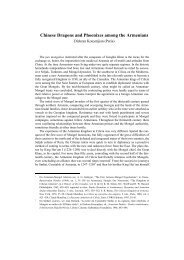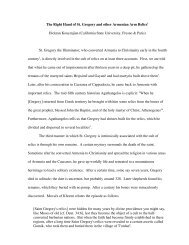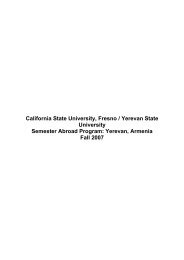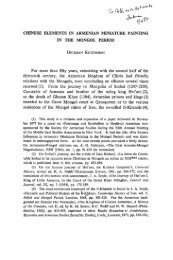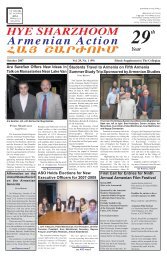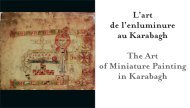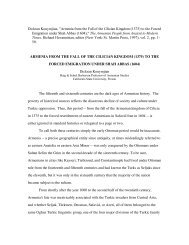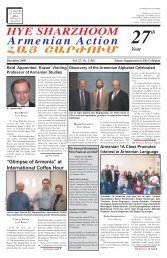Sirarpie Der Nersessian (1896-1989). Pioneer of Armenian Art History
Sirarpie Der Nersessian (1896-1989). Pioneer of Armenian Art History
Sirarpie Der Nersessian (1896-1989). Pioneer of Armenian Art History
Create successful ePaper yourself
Turn your PDF publications into a flip-book with our unique Google optimized e-Paper software.
chapter 34<br />
2<br />
<strong>Sirarpie</strong> <strong>Der</strong> <strong>Nersessian</strong> (<strong>1896</strong>–<strong>1989</strong>)<br />
<strong>Pioneer</strong> <strong>of</strong> <strong>Armenian</strong> <strong>Art</strong> <strong>History</strong><br />
Dickran Kouymjian<br />
<strong>Sirarpie</strong> <strong>Der</strong> <strong>Nersessian</strong> was the world’s foremost authority on <strong>Armenian</strong> art as<br />
well as a renowned specialist in Byzantine art. It is she who established the principles<br />
for the study <strong>of</strong> <strong>Armenian</strong> manuscript illuminations and developed its methodology.<br />
She was the discipline’s real pioneer and its most illustrious representative. She<br />
was a tireless researcher and writer with Wfteen books, one hundred articles, and forty<br />
reviews; she contributed articles in festschrifts for most <strong>of</strong> the eminent medieval,<br />
Byzantine, and <strong>Armenian</strong> scholars <strong>of</strong> the twentieth century. 1<br />
<strong>Der</strong> <strong>Nersessian</strong> was born to an upper-middle-class family in Constantinople in<br />
<strong>1896</strong>; her father, Mihran, was a well-known printer in the Ottoman capital and her<br />
mother, Akabi, the sister <strong>of</strong> Archbishop Maghakia Ormanian, patriarch <strong>of</strong> Constantinople<br />
and a distinguished church scholar and historian who lived with the family. 2<br />
Orphaned at a young age, <strong>Der</strong> <strong>Nersessian</strong> and her older sister, Arax, Xed to Bulgaria<br />
with an aunt—in the wake <strong>of</strong> the Turkish genocide <strong>of</strong> the <strong>Armenian</strong>s in 1915—and<br />
then on to Geneva, Switzerland. Her uncle, Archbishop Ormanian, had an enormous<br />
inXuence on her life, as she so <strong>of</strong>ten mentioned, and he inspired her to become a<br />
historian. As the <strong>Armenian</strong> patriarch from <strong>1896</strong> to 1908, he was the oYcial leader <strong>of</strong><br />
the entire <strong>Armenian</strong> community in the Ottoman Empire and answered directly to<br />
the sultan. In 1910 he went to the <strong>Armenian</strong> monastery <strong>of</strong> St James in Jerusalem to<br />
complete the third and Wnal volume <strong>of</strong> his massive <strong>History</strong> <strong>of</strong> the <strong>Armenian</strong> Nation. 3<br />
He returned to Constantinople in 1918 and died the same year after his nieces were<br />
already settled in Paris. Unfortunately, his death and that <strong>of</strong> their aunt in the same<br />
year left the young <strong>Der</strong> <strong>Nersessian</strong> girls without resources or relatives except for their<br />
older brother, Boghos, who stayed in Constantinople. Supporting herself during college,<br />
very unusual for a woman in those years, <strong>Der</strong> <strong>Nersessian</strong> went from the University<br />
483
484 <strong>Sirarpie</strong> <strong>Der</strong> <strong>Nersessian</strong> (<strong>1896</strong>–<strong>1989</strong>)<br />
<strong>of</strong> Geneva to the École des hautes études in Paris, where, through her great tenacity,<br />
she pursued her distinguished academic career.<br />
<strong>Der</strong> <strong>Nersessian</strong>’s teachers were the great Wgures <strong>of</strong> Byzantine and medieval studies<br />
<strong>of</strong> the time. In 1922 she was taken on as an assistant by Gabriel Millet, the renowned<br />
early Christian and Byzantine art historian, to help organize the world’s foremost<br />
photographic archive <strong>of</strong> early Christian and Byzantine archaeology and iconography<br />
at the École des hautes études, inspiring her gradual drift from history to art history.<br />
She also studied with such luminaries as Henri Focillion, Charles Diehl, and Emile<br />
Mâle, the leading scholars in medieval art and art history, as well as with the linguist<br />
and Armenologist Antoine Meillet. Her main access to <strong>Armenian</strong> scholarship was<br />
through the impressive works <strong>of</strong> her uncle. It was principally with Gabriel Millet that<br />
her career was shaped toward Byzantine and, secondarily, <strong>Armenian</strong> art, especially<br />
manuscript illumination. In 1929, together with Millet, she published her Wrst major<br />
study on the illustrations <strong>of</strong> the <strong>Armenian</strong> Psalter. 4 Five years later, after completing<br />
a series <strong>of</strong> long articles on Byzantine miniatures, she returned to <strong>Armenian</strong> art to<br />
examine the very beginnings <strong>of</strong> manuscript illumination in her Wrst English-language<br />
article, “The Date <strong>of</strong> the Initial Miniatures <strong>of</strong> the Etchmiadzin Gospel.” 5 Forty years<br />
after her Wrst article, she again attacked the study <strong>of</strong> Byzantine psalm books, this time<br />
publishing an entire volume devoted to the famous eleventh-century marginal psalter<br />
in the British Library. 6 One <strong>of</strong> her two doctoral theses was also on the miniatures <strong>of</strong><br />
Barlaam and Joasaph in the Byzantine tradition. 7 In between there were dozens <strong>of</strong><br />
articles on Byzantine art, including a major study <strong>of</strong> the tenth-century Menologium<br />
<strong>of</strong> Basil I. 8 Her precocious engagement in the interwar period made <strong>Der</strong> <strong>Nersessian</strong><br />
one <strong>of</strong> the pioneers in the study <strong>of</strong> Byzantine illumination, a discipline just beginning<br />
to establish itself in the broad domain <strong>of</strong> Byzantine art, then considered a subdiscipline<br />
<strong>of</strong> early Christian and medieval art.<br />
After some years <strong>of</strong> teaching as an assistant at the École des hautes études, she<br />
was invited in 1930 to join the art history faculty <strong>of</strong> Wellesley College near Boston.<br />
She eventually became chairperson <strong>of</strong> the art history department and director <strong>of</strong> the<br />
university’s Farnsworth Museum. In 1946 she was invited to Dumbarton Oaks, the<br />
newly established Byzantine center <strong>of</strong> Harvard University in Washington, D.C., as<br />
one <strong>of</strong> its Wrst senior fellows and resident scholar, which reinforced her research in<br />
Byzantine studies. She held that post as well as that <strong>of</strong> pr<strong>of</strong>essor at Harvard University<br />
until her retirement in 1963, after which she moved back to Paris.<br />
One must, however, consider her personal specialty as <strong>Armenian</strong> art, particularly<br />
the discipline she pioneered, the interrelations <strong>of</strong> <strong>Armenian</strong> and Byzantine art, especially<br />
in manuscript illumination. Already during the war years she gave a series <strong>of</strong><br />
lectures in New York at the Pierpoint Morgan Library in French under the auspices<br />
<strong>of</strong> New York University and the École libre des hautes études, the “resistance movement”<br />
<strong>of</strong> exiled French intellectuals. These lectures were eventually published in 1945<br />
by Harvard University Press under the title Armenia and the Byzantine Empire.<br />
It is tempting to think <strong>of</strong> <strong>Sirarpie</strong> <strong>Der</strong> <strong>Nersessian</strong> as a feminist before feminism.
I do not think she would have approved <strong>of</strong> such a description, even though she never<br />
married and much <strong>of</strong> her adult life, in the personal realm, was shared with women.<br />
Motherless at age nine, fatherless at eighteen, she lived with her aunt (1914–18) and<br />
her sister, Arax, until the latter’s marriage, but the untimely death <strong>of</strong> her sister’s<br />
husband in 1947 brought the sisters together again. Arax died a few years before<br />
<strong>Sirarpie</strong> after a long illness. The <strong>Der</strong> <strong>Nersessian</strong> sisters shared a common house at<br />
Dumbarton Oaks (1947–63), known afterward as the “<strong>Der</strong> <strong>Nersessian</strong> house,” and an<br />
apartment in the sixteenth arrondissement <strong>of</strong> Paris. Though she was regarded by<br />
students and even colleagues as an extremely well organized teacher, researcher, and<br />
administrator, she was also known for her keen sense <strong>of</strong> humor; for example, during<br />
a social gathering when she was asked, “Where is your husband, Pr<strong>of</strong>essor <strong>Der</strong> <strong>Nersessian</strong>?”<br />
she quipped, “I am the husband.” 9<br />
Though she was a pioneer as a female medievalist, she never made much <strong>of</strong> it. She<br />
was the Wrst woman to teach Byzantine art in a woman’s college, the Wrst woman to<br />
be decorated with the very distinguished medal <strong>of</strong> Saint Gregory the Illuminator by<br />
His Holiness Catholicos Vazgen I (1960), the Wrst woman invited to lecture at the<br />
prestigious Collège de France in Paris, the only woman in her time to gain full pr<strong>of</strong>essorship<br />
at Dumbarton Oaks, and the second woman to be honored with a gold<br />
medal from the Society <strong>of</strong> Antiquaries <strong>of</strong> London (1970).<br />
While teaching in America, she Wnally completed her French doctorate with the<br />
required two major dissertations, both published in 1936–37: one devoted to Byzantine<br />
manuscript illumination, L’Illustration du “Roman de Barlaam et Joasaph,” and the other<br />
to <strong>Armenian</strong> miniatures, Manuscrits arméniens illustrés des 12e, 13e, et 14e siècles de la Bibliothèque<br />
des Pères Mekhitharistes de Venise. Each <strong>of</strong> these books received a special prize. 10<br />
Thus, Byzantine and <strong>Armenian</strong> manuscript studies were to be the poles <strong>of</strong> a career<br />
extending over six decades.<br />
Though scholars before her had studied <strong>Armenian</strong> manuscript art—notably Father<br />
and later Catholicos Garegin Yovsēp’ian—it was <strong>Der</strong> <strong>Nersessian</strong> who established the<br />
parameters <strong>of</strong> the discipline and provided a conceptualization <strong>of</strong> its scope and characteristics.<br />
She was always known for her sense <strong>of</strong> organization and order. Because<br />
she was so Wrmly grounded in Byzantine and European art with a Wne appreciation<br />
<strong>of</strong> Islamic painting as well, <strong>Der</strong> <strong>Nersessian</strong> was able to demonstrate that <strong>Armenian</strong><br />
art was not just a provincial oVshoot <strong>of</strong> Byzantine art but a distinct cultural expression<br />
with its own characteristics. Building on the studies <strong>of</strong> Yovsēp’ian and always<br />
using clear language replete with concrete references, she laid out the essentials <strong>of</strong><br />
<strong>Armenian</strong> iconography, deWned the styles <strong>of</strong> various periods, reconstructed numerous<br />
workshops, and revealed the characteristic features <strong>of</strong> the most proliWc painters.<br />
This was <strong>of</strong>ten done in conjunction with the publication <strong>of</strong> catalogs <strong>of</strong> important<br />
collections <strong>of</strong> illuminated <strong>Armenian</strong> manuscripts: the Mekhitarist Library Collection<br />
in Venice (partial); the Chester Beatty Collection, Dublin; the Freer Gallery <strong>of</strong> <strong>Art</strong>,<br />
Washington, D.C.; the Walters Gallery <strong>of</strong> <strong>Art</strong>, Baltimore; the Library <strong>of</strong> the <strong>Armenian</strong><br />
Prelacy, New Julfa, Isfahan. 11 Dickran Kouymjian 485
486 <strong>Sirarpie</strong> <strong>Der</strong> <strong>Nersessian</strong> (<strong>1896</strong>–<strong>1989</strong>)<br />
<strong>Der</strong> <strong>Nersessian</strong>’s early historical training and her excellent command <strong>of</strong> classical,<br />
Western, and oriental languages inclined her toward providing at every step <strong>of</strong> the<br />
way a textual basis in her art-historical research. The text <strong>of</strong> manuscripts, especially<br />
the colophons <strong>of</strong> scribes and painters, were as important to her as the images. More<br />
than once she wrote pure history or analyses <strong>of</strong> liturgical and other texts. Her historical<br />
scholarship was not only impeccable but also methodologically exemplary and<br />
always based on primary sources.<br />
I believe it would be more instructive to trace the way <strong>Der</strong> <strong>Nersessian</strong> treated<br />
some <strong>of</strong> the problems in her last book as a paradigm <strong>of</strong> her approach to scholarship<br />
than to provide an annotated catalog <strong>of</strong> her important works (see the bibliography).<br />
For years she spoke to close colleagues about a major study on Cilician <strong>Armenian</strong> art.<br />
This last monograph in two volumes, titled Miniature Painting in the <strong>Armenian</strong> Kingdom<br />
<strong>of</strong> Cilicia from the Twelfth to the Fourteenth Century, was issued posthumously in 1993. Her<br />
Wrst book on <strong>Armenian</strong> art, published sixty years earlier, was already deeply immersed<br />
in precisely the same period. During the decades between them, <strong>Der</strong> <strong>Nersessian</strong> meticulously<br />
gathered notes and photographs <strong>of</strong> the 150 surviving illustrated manuscripts<br />
and fragments executed by artists working in Cilician Armenia. Many <strong>of</strong> the major<br />
monuments she had already analyzed in separate articles or as chapters in books and<br />
catalogs, including two <strong>of</strong> the most densely illustrated manuscripts <strong>of</strong> the most<br />
distinguished artist <strong>of</strong> the period, T’oros Roslin. After retiring she worked tirelessly<br />
on this major opus, but other commitments, the care <strong>of</strong> her sister, Arax, during the<br />
very long illness before her death, and, Wnally, her own age delayed its completion<br />
until the end <strong>of</strong> her life. She died while reviewing and revising the Wnal manuscript<br />
with the help <strong>of</strong> art historian and late disciple Sylvia Agemian.<br />
Sumptuously printed with 666 black-and-white illustrations and 51 color plates,<br />
Miniature Painting <strong>of</strong> the <strong>Armenian</strong> Kingdom <strong>of</strong> Cilicia is a vast chronological investigation<br />
<strong>of</strong> the history <strong>of</strong> Cilician book art. Yet, it has neither introduction nor conclusion.<br />
Explanation <strong>of</strong> the massive data and insights or generalities to be derived from them<br />
are given as the author moves through section after section, discussing artists and<br />
patrons and schools and monasteries. One suspects it was a matter <strong>of</strong> time, and none<br />
was left for such niceties as beginnings and endings or even in some cases, notes. But<br />
there is continuity throughout, as the story <strong>of</strong> Cilician illumination moves along from<br />
decade to decade. Of the six chapters, the last is devoted entirely to portraiture and<br />
the other Wve to the history <strong>of</strong> Cilician art from start to Wnish. The Wfth chapter is<br />
principally about the proliWc artist-scribe Sargis Pidsak and the slow decline in painting<br />
in the fourteenth century paralleling the gradual diminishing <strong>of</strong> the power <strong>of</strong> the<br />
<strong>Armenian</strong> kings.<br />
The initial chapter <strong>of</strong> the book treats the beginning <strong>of</strong> Cilician painting in the<br />
Wrst decades <strong>of</strong> the twelfth century. <strong>Der</strong> <strong>Nersessian</strong> starts by establishing in clear<br />
terms the necessity to reject received notions based on faulty information: “The general<br />
picture <strong>of</strong> the early stages <strong>of</strong> miniature painting in Cilicia had been distorted<br />
through the erroneous dating and attribution <strong>of</strong> the Gospels <strong>of</strong> the University <strong>of</strong>
Dickran Kouymjian 487<br />
Tübingen, MA.XIII.I, supposed to have been illustrated in 1113 at the monastery <strong>of</strong><br />
Drazark. In his publication, Josef Strzygowski had relied on the information provided<br />
by the dealer. . . . Like many others I had accepted the date and provenance <strong>of</strong> this<br />
manuscript. . . . [However] the entire copy <strong>of</strong> the colophon <strong>of</strong> the Tübingen Gospels<br />
is a falsiWcation.” 12 Rather than a Cilician work <strong>of</strong> 1113, the miniatures show stylistically<br />
the manuscript and its illustrations to be <strong>of</strong> the late twelfth or early thirteenth century<br />
from Greater Armenia to the northeast. Ironically, the Wrst authentic illustrated<br />
Cilician manuscript is in fact dated 1113 and is a gospel copied at Drazark, a poorly<br />
executed manuscript by a scribe-artist who had little experience and access only to<br />
inadequate models. Thus, the illumination is unskilled and the book unconventionally<br />
laid out. Despite its rudimentary quality, <strong>Der</strong> <strong>Nersessian</strong> treats the codex in great<br />
depth simply because it is the only known illustrated work from Cilicia in the Wrst<br />
half <strong>of</strong> the twelfth century. She concludes her analysis judiciously: “[I]n the absence<br />
<strong>of</strong> contemporary illustrated manuscripts we have no way <strong>of</strong> knowing whether or not<br />
this mediocre work is representative <strong>of</strong> Cilician miniature painting in the Wrst half <strong>of</strong><br />
the twelfth century.” 13<br />
With such deliberate caution she moves forward at a steady pace, tying together<br />
various threads to create a solid fabric, one that reconstructs the relationship between<br />
scribe, artist, and patron that produced the whole cloth <strong>of</strong> artistic and intellectual<br />
life <strong>of</strong> <strong>Armenian</strong> Cilicia. The Xowering <strong>of</strong> the school was in the second half <strong>of</strong> the<br />
thirteenth century, but <strong>Der</strong> <strong>Nersessian</strong> chooses not to rush to it in order to enhance<br />
the achievements <strong>of</strong> the previous century, which made it possible. Each step on the<br />
way is clear and carefully considered. Alesser scholar might have been tempted to<br />
signal, in anticipation, what was to come.<br />
Chapters 1 and 2A, presenting successively the second half <strong>of</strong> the twelfth and the<br />
Wrst half <strong>of</strong> the thirteenth century, could have served as introductory material to the<br />
brilliance <strong>of</strong> the following Wfty years. Such an approach held little interest for <strong>Sirarpie</strong><br />
<strong>Der</strong> <strong>Nersessian</strong>. In her scholarship there is never exaggeration or sensation. I <strong>of</strong>ten<br />
recall her polite remonstrances toward some <strong>of</strong> my own more fanciful conjectures on<br />
the iconography <strong>of</strong> <strong>Armenian</strong> Pentecost when I discussed them with her more than<br />
twenty-Wve years ago and how she guided me quite calmly away from hypotheses that<br />
she knew would be unproductive, yet without the slightest bit <strong>of</strong> elevated authority. 14<br />
Such Wrm yet sober language is at the very core <strong>of</strong> her method.<br />
In analyzing the painting in the <strong>Armenian</strong> kingdom from 1150 to 1250, <strong>Der</strong> <strong>Nersessian</strong><br />
took into consideration even the artistically least signiWcant works, carefully<br />
assessing how or why an artist had failed in technique or in iconographic comprehension<br />
<strong>of</strong> a scene, but without denigrating an untalented scribe or monk with useless<br />
adjectives on the poor quality <strong>of</strong> his art. She just explains carefully, yet with great<br />
economy, why a painting or an artist’s work falls short or why it is exceptional, always<br />
providing the source <strong>of</strong> the artist’s inspiration, the relation <strong>of</strong> his work to that <strong>of</strong> the<br />
entire period and to neighboring scriptoria, and the place <strong>of</strong> a certain illuminated<br />
gospel in the context <strong>of</strong> the artist-scribe’s entire output.
488 <strong>Sirarpie</strong> <strong>Der</strong> <strong>Nersessian</strong> (<strong>1896</strong>–<strong>1989</strong>)<br />
For such a balanced view, <strong>Der</strong> <strong>Nersessian</strong> has no equal in <strong>Armenian</strong> art studies.<br />
When she speaks <strong>of</strong> the production <strong>of</strong> an artist or scribe, she provides as background<br />
virtually everything there is to know about the person: all manuscripts (illustrated or<br />
not) copied by the scribe, including lost codices; the period <strong>of</strong> the artist’s Xourishing;<br />
the monasteries and teachers who formed his skills; his patrons (in the Cilician<br />
period almost exclusively aristocratic or upper clergy); and exhaustive bibliographical<br />
information, <strong>of</strong>ten <strong>of</strong> the most obscure variety.<br />
Such is the case, for example, <strong>of</strong> a certain scribe named Kozma, who is responsible<br />
for four gospels copied on the northern fringes <strong>of</strong> Cilicia in the Wrst decades <strong>of</strong><br />
the thirteenth century. <strong>Der</strong> <strong>Nersessian</strong> creates a persona for Kozma: “We do not<br />
know where Kozma had been trained. He probably had come to Hromkla (the seat<br />
<strong>of</strong> the Catholicos <strong>of</strong> All <strong>Armenian</strong>s) from Armenia, for the portraits show closer<br />
aYnities with the miniatures <strong>of</strong> manuscripts copied in the mother country . . . than<br />
they do with the elegant style developed in Cilicia.” 15 Yet, she is careful to point out<br />
that Kozma should not be confused with his namesake, another scribe who is a near<br />
contemporary. Thus, she is able to bring together four gospel books, which she attributes<br />
to Kozma on a careful comparison <strong>of</strong> style, without failing to mention other<br />
manuscripts, which were by another Kozma.<br />
Amore striking example <strong>of</strong> the startling results that <strong>Der</strong> <strong>Nersessian</strong> achieves<br />
through careful scholarship combined with the imagination <strong>of</strong> a detective concerns<br />
a group <strong>of</strong> three undated gospel manuscripts <strong>of</strong> the late twelfth or the early thirteenth<br />
century and their relation to one another, otherwise unclear because <strong>of</strong> disparate<br />
scenes and iconographic elements in them. Because <strong>of</strong> her familiarity with all<br />
periods <strong>of</strong> <strong>Armenian</strong> painting, she was able to bring to the discussion a late-sixteenthcentury<br />
gospel painted at Khizan by a certain Martiros with iconographical elements<br />
from each <strong>of</strong> the three manuscripts painted four hundred years earlier, but which the<br />
three did not share with one another. Her almost understated remarks follow: “One<br />
<strong>of</strong> the models used by Martiros <strong>of</strong> Hizan, directly or indirectly, must have been the<br />
common prototype <strong>of</strong> our three Gospels, for it would be a very strange coincidence<br />
indeed if among the manuscripts to which he had access there happened to be one<br />
related” to each <strong>of</strong> the gospels. 16<br />
Throughout the book <strong>Der</strong> <strong>Nersessian</strong> carefully corrects her rare mistakes <strong>of</strong> the<br />
past and those <strong>of</strong> others, never passing judgment on earlier scholarship, just providing<br />
the reasons why previous opinions were in error and what new data have modi-<br />
Wed the accepted position. She is also remarkably objective in her judgments, with no<br />
trace <strong>of</strong> nationalism <strong>of</strong> any sort. This is exemplary scholarship for someone who had<br />
spent an entire life deWning and developing the new Weld <strong>of</strong> <strong>Armenian</strong> miniature<br />
painting. Where others are quick to show that a certain feature is an <strong>Armenian</strong> “Wrst”<br />
(but <strong>of</strong> course this curious sort <strong>of</strong> chauvinism does not apply only to members <strong>of</strong><br />
small nations), she is content to point out new departures in restrained terms, as<br />
exempliWed in her description <strong>of</strong> the fragments <strong>of</strong> the lost gospel reused as guard<br />
sheets in a later manuscript:
Dickran Kouymjian 489<br />
I have dwelt at some length on the miniatures <strong>of</strong> the two Xyleaves, because their interest<br />
transcends the limits <strong>of</strong> Cilician art, bringing, as they do, a notable contribution<br />
toward the study <strong>of</strong> the Stavronikita type <strong>of</strong> evangelist portraits. Among the East<br />
Christians, the <strong>Armenian</strong>s appear to have been the only ones interested in these types;<br />
no corresponding examples are known in Syriac or Coptic Gospels, nor, strangely<br />
enough, in Georgian manuscripts where the illustrations are remarkably close to the<br />
Byzantine models. . . . Ins<strong>of</strong>ar as the study <strong>of</strong> Cilician painting is concerned, the miniatures<br />
<strong>of</strong> the Xyleaves have a somewhat marginal role. They testify to the skill <strong>of</strong> the<br />
painter who faithfully reproduced the Greek model, but . . . are less interesting than<br />
. . . the Lwów Gospels, which, based also on Greek models, show the translation <strong>of</strong><br />
their style into a diVerent idiom. 17<br />
A Wnal example will underline her economy <strong>of</strong> expression—perhaps modesty is a<br />
better word. In the section devoted to <strong>Armenian</strong> painting’s most brilliant and famous<br />
artist, T’oros Roslin (active 1256–68)—the longest part <strong>of</strong> the book devoted to a single<br />
individual, about whom <strong>Der</strong> <strong>Nersessian</strong> had written over and again—she underlines<br />
“Roslin’s ability to convey deep emotion without undue emphasis,” which appropriately<br />
deWnes her own personality. She, too, was for understatement, the idea that<br />
less is <strong>of</strong>ten more. Her most extravagant claims or praise for Cilician art come in this<br />
chapter. Here is her description <strong>of</strong> a painting <strong>of</strong> the descent from the cross: “This<br />
composition, in which Roslin’s hand can be recognized without hesitation, surpasses<br />
in artistic quality the contemporary Byzantine examples.” Or for another scene by<br />
Roslin, she writes, “Christ enthroned between the Virgin and St. John the Baptist—<br />
a Wgure comparable in its noble grandeur to the Wnest medieval examples—is no<br />
longer the severe judge but the compassionate Savior.” And for yet another, “The<br />
compositional design, the delicate modeling <strong>of</strong> the individual Wgures, and the subtle<br />
color harmonies show Roslin’s work at its best, equaling in artistic quality some <strong>of</strong><br />
the Wnest Byzantine miniatures.” 18<br />
Miniature Painting in the <strong>Armenian</strong> Kingdom <strong>of</strong> Cilicia is incontestably her magnum<br />
opus. It is at once a precise and ample study <strong>of</strong> the period and an encyclopedic<br />
compendium on <strong>Armenian</strong> art in general and the history <strong>of</strong> the medieval <strong>Armenian</strong><br />
kingdom.<br />
It has been impossible in this context to compare <strong>Der</strong> <strong>Nersessian</strong>’s earlier positions<br />
on <strong>Armenian</strong> art with corrected or augmented ones in her Wnal study, though an<br />
example was given earlier concerning the Tübingen Gospels. The specialized iconographic<br />
or paleographic background necessary to understand each point would have<br />
required much more space. Rather, I have emphasized her methodology. I do not<br />
mean to suggest that others before and contemporary to <strong>Der</strong> <strong>Nersessian</strong> did not<br />
uphold the same rigorous standards. But few are the scholars from any period and<br />
in any discipline who are able to combine such diverse personal resources and<br />
bring the beneWt <strong>of</strong> such erudition so gracefully to the exposition <strong>of</strong> their research.<br />
Her comments on art are in part so convincing because they are grounded Wrmly on
490 <strong>Sirarpie</strong> <strong>Der</strong> <strong>Nersessian</strong> (<strong>1896</strong>–<strong>1989</strong>)<br />
paleography, codicology, and historical texts, especially colophons. Through these<br />
scribal annotations she was able to piece together the story <strong>of</strong> <strong>Armenian</strong> manuscript<br />
production, and in this she followed her admired older friend Catholicos Garegin<br />
Yovsēp’ian, who, in addition to studying <strong>Armenian</strong> art, also published in 1913 the Wrst<br />
systematic illustrated survey <strong>of</strong> <strong>Armenian</strong> paleography and, at the end <strong>of</strong> his life in<br />
1951, the Wrst systematic collection <strong>of</strong> <strong>Armenian</strong> manuscript colophons, the latter<br />
volume a constant companion <strong>of</strong> <strong>Der</strong> <strong>Nersessian</strong>. 19<br />
Though it is true that few scholars have had the good fortune to actively publish<br />
into their nineties, it is also true that few <strong>of</strong> us, given that chance, could lay claim to<br />
the integrity and thoroughness <strong>of</strong> <strong>Der</strong> <strong>Nersessian</strong>’s labor. Her students at Wellesley<br />
were in awe <strong>of</strong> her knowledge, sophistication, generosity, and teaching skills. Because<br />
<strong>of</strong> her research post at Dumbarton Oaks, she produced few graduate students, though<br />
she was always ready to receive young scholars; she answered letters <strong>of</strong> inquiry promptly<br />
and amply. She always encouraged newer scholars and helped generously with her<br />
knowledge and experience. In her last decades in Paris her apartment was always open<br />
to old colleagues and students. She never refused to invite anyone who needed her<br />
help for afternoon tea, usually oVering a thick demitasse <strong>of</strong> <strong>Armenian</strong> coVee. To the<br />
end the patter <strong>of</strong> her quick steps on the parquet Xoors <strong>of</strong> the avenue de Versailles<br />
apartment as she came to greet her guests announced the wonderful accepting smile<br />
that was to greet them as the door opened. She kept up the pace in her nineties and<br />
even began to indulge herself with an occasional cigarette, a chocolate, and discussions<br />
<strong>of</strong> current <strong>Armenian</strong> and world aVairs. Yet, but for a few close friends, <strong>Sirarpie</strong><br />
<strong>Der</strong> <strong>Nersessian</strong> will be remembered for her books and articles, glowing with a timeless<br />
purity both in method and in the credibility <strong>of</strong> the data. They will serve as paradigms<br />
<strong>of</strong> expression and reWned analysis for generations <strong>of</strong> future art scholars.<br />
Notes<br />
Elements <strong>of</strong> this chapter were presented at the Thirty-Fifth International Congress <strong>of</strong> Orientalists,<br />
Budapest, July 1997, the theme <strong>of</strong> that year’s congress being distinguished Orientalists<br />
<strong>of</strong> the past. Research on <strong>Sirarpie</strong> <strong>Der</strong> <strong>Nersessian</strong> was carried out in part under a grant from<br />
the Bertha and John Garabedian Charitable Foundation, Fresno, California.<br />
1. Aselect bibliography is included at the end <strong>of</strong> this essay. Among the scholar friends she<br />
honored with essays are Gustave Schlumberger, Nicolas Iorga, Henri Focillon, Paul Peters,<br />
Henri Grégoire, Bella da Costa Greene, A. M. Friend Jr., Alexander Vasiliev, Robert Pierce<br />
Casey, George Ostrogorsky, Francis Dvornik, V. N. Lazarev, Otto Demus, Dorothy E. Minor,<br />
and Haïg Berbérian. Acomplete bibliography <strong>of</strong> <strong>Sirarpie</strong> <strong>Der</strong> <strong>Nersessian</strong>’s works can be found<br />
in the following references: Revue des études arméniennes, n.s., 3 (1966): 3–6; <strong>Der</strong> <strong>Nersessian</strong>,<br />
Études byzantines et arméniennes. Byzantine and <strong>Armenian</strong> Studies, 2:167–70; and Revue des études<br />
arméniennes, n.s., 21 (1988–89): 8–11.<br />
2. Details on <strong>Der</strong> <strong>Nersessian</strong>’s life and career can be found in the carefully prepared biography<br />
by Jelisaveta Stanojevich Allen, “<strong>Sirarpie</strong> <strong>Der</strong> <strong>Nersessian</strong>.”Obituaries appeared, inter<br />
alia, in Mahé and Garsoïan, “<strong>Sirarpie</strong> <strong>Der</strong> <strong>Nersessian</strong> <strong>1896</strong>–<strong>1989</strong>”; J. Allen et al., “<strong>Sirarpie</strong> <strong>Der</strong><br />
<strong>Nersessian</strong> <strong>1896</strong>–<strong>1989</strong>”; and a number <strong>of</strong> <strong>Armenian</strong> newspapers and scientiWc journals. For her
Dickran Kouymjian 491<br />
publications, see note 5 and the bibliography. Anewly published work, the Wrst in a projected<br />
three volume series, provides the scholar’s systematic archives on <strong>Armenian</strong> painting with all<br />
her unpublished notes, as well as a biography lavished with photographs in the form <strong>of</strong> a<br />
chronology (Agémian, Archives <strong>Sirarpie</strong> <strong>Der</strong> <strong>Nersessian</strong>, Catalogue).<br />
3. Ormanean, Azgapatum.<br />
4. <strong>Der</strong> <strong>Nersessian</strong> with Millet, “Le Psautier arménien illustré.”<br />
5. The articles on Byzantine miniatures are conveniently listed in the bibliography <strong>of</strong> <strong>Sirarpie</strong><br />
<strong>Der</strong> <strong>Nersessian</strong> published on the occasion <strong>of</strong> her seventieth birthday in Revue des études<br />
arméniennes, n.s., 3 (1966): 3–6. The bibliography was brought up to date in <strong>Der</strong> <strong>Nersessian</strong>,<br />
Études byzantines et arméniennes. Byzantine and <strong>Armenian</strong> Studies 2:167–70, and again after her<br />
death in Revue des études arméniennes, n.s., 21 (1988–89): 8–11.<br />
6. <strong>Der</strong> <strong>Nersessian</strong>, L’Illustration des psautiers grecs.<br />
7. <strong>Der</strong> <strong>Nersessian</strong>, L’Illustration du “Roman de Barlaam et Joasaph.” <strong>Der</strong> <strong>Nersessian</strong>, “Illustrations<br />
<strong>of</strong> the Homilies <strong>of</strong> Gregory <strong>of</strong> Nazianzus.”<br />
9. J. S. Allen, “<strong>Sirarpie</strong> <strong>Der</strong> <strong>Nersessian</strong>,” 337.<br />
10. The Wrst volume, Roman de Barlaam et Joasaph, received the Fould Prize <strong>of</strong> the Académie<br />
des Inscriptions et Belles Lettres, Paris, and the second, Manuscrits arméniennes illustrès,<br />
received the Prize <strong>of</strong> the Association des Études greques, Paris.<br />
11. These are listed in the bibliography.<br />
12. <strong>Der</strong> <strong>Nersessian</strong>, Miniature Painting, 1.<br />
13. <strong>Der</strong> <strong>Nersessian</strong>, Miniature Painting, 3.<br />
14. Kouymjian, “Problem <strong>of</strong> the Zoomorphic Figure.”<br />
15. <strong>Der</strong> <strong>Nersessian</strong>, Miniature Painting, 3, 11 n. 86, 12.<br />
16. Ibid., 29<br />
17. Ibid., 35.<br />
18. Ibid., 59, 63a, 63b.<br />
19. Yovsēp’ian, Album <strong>of</strong> <strong>Armenian</strong> Paleography For a recent discussion <strong>of</strong> his paleographic<br />
insights, see Kouymjian, “Garegin Yovsēp’ian.” Yovsēp’ian’s Colophons <strong>of</strong> Manuscripts.<br />
Select Bibliography <strong>of</strong> Works by <strong>Sirarpie</strong> <strong>Der</strong> <strong>Nersessian</strong><br />
“Illustrations de Nicéphore Phocas et de l’épopée Byzantine: Répertoire méthodique.” In<br />
Mélanges oVerts à Gustave Schlumberger. Paris: P. Geuthner, 1924.<br />
With Gabriel Millet. “Le Psautier arménien illustré.” Revue des études arméniennes 9 (1929):<br />
137–81.<br />
“The Date <strong>of</strong> the Initial Miniatures <strong>of</strong> the Etchmiadzin Gospel.” <strong>Art</strong> Bulletin 15, no. 4 (1933):<br />
327–60. Reprinted in <strong>Der</strong> <strong>Nersessian</strong>, Études byzantines et arméniennes, 1: 533–58.<br />
L’Illustration du “Roman de Barlaam et Joasaph.” 2 vols. Paris: Librairie E. de Boccard, 1936–37.<br />
Manuscrits arméniens illustrès des XIIe, XIIIe et XIVe siècles de la Bibliothèque des Pères Mekhitaristes<br />
de Venise. 2 vols. Paris: Librairie E. de Boccard, 1937.<br />
“The Direct Approach in the Study <strong>of</strong> <strong>Art</strong> <strong>History</strong>.” College <strong>Art</strong> Journal 1 (1942): 54–60.<br />
“Une apologie des images du septième siècle.” Byzantion 14 (1944/45): 58–87. Reprinted in <strong>Der</strong><br />
<strong>Nersessian</strong>, Études byzantines et arméniennes, 1: 379–404.<br />
Armenia and the Byzantine Empire. Cambridge, Mass.: Harvard University Press, 1947.<br />
The Chester Beatty Library: A Catalogue <strong>of</strong> the <strong>Armenian</strong> Manuscripts, with an Introduction on the<br />
<strong>History</strong> <strong>of</strong> <strong>Armenian</strong> <strong>Art</strong>. 2 vols. Dublin: Hodges, Figgis and Co., 1958.
492 <strong>Sirarpie</strong> <strong>Der</strong> <strong>Nersessian</strong> (<strong>1896</strong>–<strong>1989</strong>)<br />
“The Illustrations <strong>of</strong> the Homilies <strong>of</strong> Gregory <strong>of</strong> Nazianzus, Paris Gr. 510. AStudy <strong>of</strong> the Connections<br />
between Text and Images.” Dumbarton Oaks Papers 16 (1962): 195–228. Reprinted<br />
in <strong>Der</strong> <strong>Nersessian</strong>, Études byzantines et arméniennes, 77–107.<br />
“The Kingdom <strong>of</strong> Cilician Armenia.” In A <strong>History</strong> <strong>of</strong> the Crusades, edited by K. M. Setton, vol.<br />
2, edited by R. L. WolV and H. W. Hazard. Philadelphia: University <strong>of</strong> Pennsylvania Press,<br />
1962. Reprinted in <strong>Der</strong> <strong>Nersessian</strong>, Études byzantines et arméniennes, 1: 329–52.<br />
<strong>Armenian</strong> Manuscripts in the Freer Gallery <strong>of</strong> <strong>Art</strong>. Freer Gallery <strong>of</strong> <strong>Art</strong> Oriental Series, 6. Washington,<br />
D.C.: Smithsonian Institution, 1963.<br />
“La peinture arménienne au VIIe siècle et les miniatures de l’Évangile d’Etchmiadzin.” In Actes<br />
du XIIe Congrès international d’etudes byzantines, Ochrid, 10–16 septembre, 1961. Belgrade: n.p.,<br />
1964. Reprinted in <strong>Der</strong> <strong>Nersessian</strong>, Études byzantines et arméniennes, 1: 525–32.<br />
Aght’amar: Church <strong>of</strong> the Holy Cross. Harvard <strong>Armenian</strong> Texts and Studies, 1. Cambridge, Mass.:<br />
Harvard University Press, 1965.<br />
“Armenia in the Tenth and Eleventh Centuries.” In Proceedings <strong>of</strong> the Thirteenth International<br />
Congress <strong>of</strong> Byzantine Studies, Oxford, 5–10 September 1966, edited by J. M. Hussey, D. Obolensky,<br />
and S. Runciman. London: n.p., 1967. Reprinted in <strong>Der</strong> <strong>Nersessian</strong>, Études byzantines et<br />
arméniennes, 1:323–27.<br />
The <strong>Armenian</strong>s. Ancient Peoples and Places. London: Thames and Hudson, 1969.<br />
L’Illustration des Psautiers grecs du Moyen Âge. II. Londres Add. 19352. Bibliothèque des Cahiers<br />
Archéologiques, 5. Paris: Éditions Klincksick, 1970.<br />
<strong>Armenian</strong> Manuscripts in the Walters <strong>Art</strong> Gallery. Baltimore: Trustees Walters <strong>Art</strong> Gallery, 1973.<br />
Études byzantines et arméniennes, Byzantine and <strong>Armenian</strong> Studies, (Collection <strong>of</strong> <strong>Sirarpie</strong> der<br />
<strong>Nersessian</strong>’s essays). 2 vols. Louvain: Calouste Gulbenkian Foundation/Peeters, 1973.<br />
“Le reliquaire de Skévra et l’orfèvrerie cilicienne aux XIIIe et XIVe siècles.” In Revue des etudes<br />
arméniennes, n.s., 1 (1964): 121–47. Reprinted in <strong>Der</strong> <strong>Nersessian</strong>, Études byzantines et arméniennes,<br />
705–22.<br />
With Herman Vahramian. Aght’amar (in English, Italian, <strong>Armenian</strong>). Documenti di Architettura<br />
Armena, vol. 8. Milan: Edizioni Ares, 1974.<br />
“Program and Iconography <strong>of</strong> the Frescoes <strong>of</strong> the Parecclesion.” In Paul A. Underwood, The<br />
Kariye Djami, 4: 305–49. New York: Bollingen, 1975.<br />
L’<strong>Art</strong> arménien. Paris: Flammarion, 1977. Translated under the title <strong>Armenian</strong> <strong>Art</strong> (London:<br />
Thames and Hudson, 1978).<br />
“L’évangile du roi Gagik de Kars: Jérusalem no. 2556.” Revue des études arméniennes 18 (1984):<br />
85–107.<br />
With Arpag Mekhitarian. <strong>Armenian</strong> Miniatures from Isfahan. Brussels: Les Editeurs d’<strong>Art</strong> Associés,<br />
1986.<br />
“Les portraits d’Esayi Nĉ’ec’i Supérieur de Glajor.” In <strong>Armenian</strong> Studies, Études arméniennes: In<br />
Memorium Haïg Berbérian, edited by Dickran Kouymjian. <strong>Armenian</strong> Library <strong>of</strong> the Calouste<br />
Gulbenkian Foundation. Lisbon: Gulbenkian Foundation/Coimbra, 1986.<br />
“Two Miracles <strong>of</strong> the Virgin in the Poems <strong>of</strong> Gautier de Coincy.” Dumbarton Oaks Papers 41<br />
(1987): 157–63<br />
With Sylvia Agemian. Miniature Painting in the <strong>Armenian</strong> Kingdom <strong>of</strong> Cilicia from the Twelfth to<br />
the Fourteenth Century. Introduction by Annemarie Weyl Carr. 2 vols. Dumbarton Oaks<br />
Studies, vol. 31. Washington, D.C.: Dumbarton Oaks, 1993.
Dickran Kouymjian 493<br />
Works Cited<br />
Agémian, Sylvia. Archives <strong>Sirarpie</strong> <strong>Der</strong> <strong>Nersessian</strong>, Catalogue, vol. 1, Bibliothèque arménienne de<br />
la Fondation Calouste Gulbenkian. Antelias, Lebanon: <strong>Armenian</strong> Catholicosate <strong>of</strong> Cilicia,<br />
2003.<br />
Allen, J., N. Garsoïan, I. Ševĉenko, and R. W. Thomson. “<strong>Sirarpie</strong> <strong>Der</strong> <strong>Nersessian</strong> <strong>1896</strong>–<strong>1989</strong>.”<br />
Dumbarton Oaks Papers 43 (<strong>1989</strong>): ix–xi.<br />
Allen, Jelisaveta Stanojevich. “<strong>Sirarpie</strong> <strong>Der</strong> <strong>Nersessian</strong> (b. <strong>1896</strong>): Educator and Scholar in<br />
Byzantine and <strong>Armenian</strong> <strong>Art</strong>.” In Women as Interpreters <strong>of</strong> the Visual <strong>Art</strong>s, 1820–1979, edited<br />
by Claire Richter Sherman with Adele M. Holcomb, 321–56. Westport, Conn.: Greenwood<br />
Press, 1981.<br />
Kouymjian, Dickran. “Garegin Yovsēp’ian.” In Album <strong>of</strong> <strong>Armenian</strong> Paleography, edited by M.<br />
Stone, D. Kouymjian, and H. Lehmann, 33–35. Århus, Denmark: Århus University Press,<br />
2002.<br />
———. “The Problem <strong>of</strong> the Zoomorphic Figure in the Iconography <strong>of</strong> <strong>Armenian</strong> Pentecost:<br />
APreliminary Report.” In Atti del Primo Simposio Internazionale de <strong>Art</strong>e Armena, Bergamo,<br />
1975, 403–13. Venice: Mekhitarist Press, San Lazzaro, 1978.<br />
Mahé, J.-P., and N. Garsoïan. “<strong>Sirarpie</strong> <strong>Der</strong> <strong>Nersessian</strong> <strong>1896</strong>–<strong>1989</strong>.” Revue des Études arméniennes,<br />
n.s., 21 (1988–89): 5–7.<br />
Ormanean, Maghak’ia. Azgapatum (<strong>History</strong> <strong>of</strong> the nation). 3 vols. Constantinople: <strong>Armenian</strong><br />
Patriarchate, 1912, 1914; Jerusalem: St James Monastery, 1927. Reprint, Beirut: Sevan, 1959;<br />
Antelias, Lebanon: Cilician Catholicosate, 2002.<br />
Yovsēp’ian, Garegin. Album <strong>of</strong> <strong>Armenian</strong> Paleography (in <strong>Armenian</strong>). Etchmiadzin: <strong>Armenian</strong><br />
Catholicosate, 1913.<br />
——— . Colophons <strong>of</strong> Manuscripts (in <strong>Armenian</strong>). Vol. 1. Antelias: Press <strong>of</strong> the Catholicosate <strong>of</strong><br />
the Great House <strong>of</strong> Cilicia, 1951. <strong>Armenian</strong> colophons to 1250a.d., all published.



